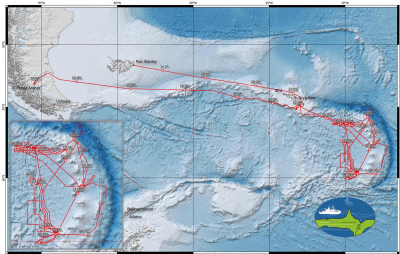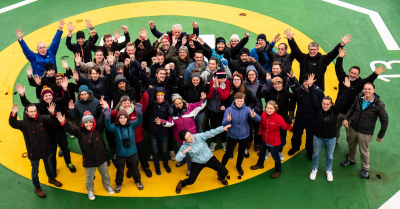- Home
- Research
- Expeditions
- 2019
- PS119
- PS119 – 8th Weekly Report
The last week at sea
PS119 – 7th Weekly Report, 27. – 31.5.19
After our storm on last Friday, the sea only calmed down very slowly and station work was only possible with two CTD stations in the late night towards Saturday. The deployments were made about 60 kilometers to the West of the spreading centre on its flank. There, the seafloor is parted by North-South orientated, parallel faults covered by young sediment, and we discovered both in the sediments as well as in the water column indications for fluid circulation in the Parasound recordings. The type of fluid circulation whereby sea water is penetrating the Earth’s crust, then circulates in the young crust, and rises as warm or hot fluid at different areas of the ocean’s floor is not only known from spreading centres but also has been observed along the flanks far away from currently active spreading centres. The water samples taken by CTD showed slightly raised methane concentrations, which hinted to a fluid outflow. In addition, the first sediment cores, which we had taken there 3 weeks ago, showed profiles of pore water content, which gave hints toward inflowing and at a different site also outflowing fluids, a phenomena, which we wanted to verify or confirm by further sampling. When it became obvious that the most important sediment core could not be taken even on Saturday morning because of the sea state, we steamed eastwards and carried out our OFOBS profile in East to West direction across the spreading segment E2 on Saturday, 25th of May. At night we moved back to the CTD station and successfully took an almost eight meter long sediment core.
Shortly after RV POLARSTERN left finally the area of the East Scotia Ridge towards South Georgia, which unfortunately was only able during rough sailing conditions. In the darkness of Sunday, 26th of May, we took our last sediment core of this expedition in the Drygalski Trough. Afterwards RV POLARSTERN started her return journey, and after we reached the north-eastern side of South Georgia, steamed along the elongated island shelf directly toward the Falkland Islands in the West.
The track of the return journey we used from Monday to Thursday for further acoustic surveys with the multi-beam system Hydrosweep and the sediment penetrating sounding system Parasound. We used the station-free time to analyse data, write the cruise report, pack the expedition cargo, clean the labs and give presentations during the daily meetings on the conference room of the vessel.
With 20 gravity core, 18 CTD and 13 multi-corer stations, 10 OFOBS profiles, and 7 ROV dives with a total of 46 hours of bottom time, and despite huge weather systems in the autumn to winter season of the Furious Fifties, we achieved very successful sampling and data collections, discovered and investigated new hydrothermal vent fields, and surveyed more than 6.700 nautical miles of seafloor.
We, the scientific crew on board, are very pleased with the achieved targets. The success of our scientific work is based on the outstanding and friendly support of the vessel’s crew in all her areas (nautical, technical, deck’s crew, engine room, hospitality services, etc) and of the team of the AWI. We are grateful to Master Moritz Langhinrichs and his entire crew, who always supported us on all our requests.
It is Thursday evening, 30th May, and tomorrow morning we mooring off Port Stanley, Falkland Islands. The scientific crew will disembark, stay one night in a hotel and fly on Saturday with the weekly flight to Santiago de Chile, and on Sunday travel onwards, back to Europe.
All expedition participants are well. For a last time on this expedition, best greetings in the name of all expedition participants,
Gerhard Bohrmann, RV POLARSTERN, Thursday, 30th of Mai 2019




